Plant Summary
 Botanical Name: Hydrangea macrophylla
Botanical Name: Hydrangea macrophylla
Type: Flowering
Origin: Hydrangea macrophylla originates from Japan.
Height: Hydrangeas kept indoors grow to heights of around 60 cm (2 ft).
Soil: In particular blue varieties of this house plant require lime-free, peat-based potting mixes.
Light: These plants should be provided with a minimum of four hours worth of bright, but indirect light per day.
Humidity: Hydrangea macrophylla is quite comfortable in environments with average levels of humidity.
Temperatures: Cool to average temperatures ranging between 7 and 18 degrees C (45 to 65 degrees F) are best for this house plant.
 Water: The potting mix for Hydrangeas must be kept evenly moistened throughout their growing and flowering seasons. Soggy soil should, however, be prevented by providing adequate drainage. To prevent the potting mix from becoming alkaline, lime-free water should be used. During the winter months, the potting mix should be kept just barely moist.
Water: The potting mix for Hydrangeas must be kept evenly moistened throughout their growing and flowering seasons. Soggy soil should, however, be prevented by providing adequate drainage. To prevent the potting mix from becoming alkaline, lime-free water should be used. During the winter months, the potting mix should be kept just barely moist.
Fertiliser: A balanced (10-10-10) liquid fertiliser should be diluted (50:50) and fed fortnightly to the plant throughout spring and summer. Alternatively, a slow-release fertiliser can be used (once in spring, then again in summer).
Propagation: Hydrangea macrophylla can be propagated via stem tip cuttings. The best time to take these cuttings - which should measure approximately 10 cm (4 in) - is spring or, at the latest, in early summer. The cuttings should root well in moistened potting mix.
Description and Care Tips
While there are dozens of Hydrangea species, Hydrangea macrophylla is the best choice for indoor growing. Available in hundreds of different varieties, this species - also known as the 'Mophead' Hydrangea - certainly knows how to really show off in style.
The woody stems of this perennial shrub are densely covered by deep green, large oval leaves. In summer, huge round clusters of red, pink or white; violet-blue or blue small flowers all but completely cover this house plant.
 One of the main factors to remember when caring for Hydrangea macrophylla is that this plant needs moist soil - allowing it to dry out is likely to kill it. First signs of the soil getting too dry are yellowing leaves that eventually fall off. Provision of adequate indirect light (see above) is also vital for the health of this house plant.
One of the main factors to remember when caring for Hydrangea macrophylla is that this plant needs moist soil - allowing it to dry out is likely to kill it. First signs of the soil getting too dry are yellowing leaves that eventually fall off. Provision of adequate indirect light (see above) is also vital for the health of this house plant.
The choice of potting mix is also important, as varying pH factors can change the colour of a plant's flowers. It should, however, be noted that not all varieties will change colour, so it is important to get the desired colour and then attempt to maintain it, rather than hoping to achieve a specific colour by varying the soil's pH factor.
In essence, blue Hydrangeas require acidic soil with pH factors of 5.5 or below. Adding sulphur while the plant is in bloom will also help to maintain the lovely blue colour.
Neutral pH factors ranging between 5.5 and 7 can result in purple flowers or a mix of blue and pink flowers, while alkaline soil with a pH of 7 or higher is best to maintain the colour of pink varieties.
Unless size control is necessary, Mophead Hydrangeas do not require pruning, although cutting back approximately one third of the plant's older stems will result in a fuller, bushier appearance. If pruning is required, it should be done after the last of the flowers have faded away, avoiding damage to stems - and subsequently endangering the health of the plant - by tearing. Using sharp and clean pruners, stems should be cut - just over 1/2 cm (1/4 in) above leaf axles - at an angle of 45 degrees.
 To over-winter an indoor Hydrangea, the plant should be repotted once flowering has finished, followed by cutting back stems by half. Kept cool throughout most of the winter months, the plant should then be moved into a slightly warmer environment near the end of winter in order to encourage blooming.
To over-winter an indoor Hydrangea, the plant should be repotted once flowering has finished, followed by cutting back stems by half. Kept cool throughout most of the winter months, the plant should then be moved into a slightly warmer environment near the end of winter in order to encourage blooming.
Dried Mophead Hydrangea flowers make exceptionally beautiful additions to dried flower arrangements. To preserve the colours of the flowers, flower stems should be allowed to dry while still on the plant. Once blooms have a papery feel to them, the stems can be cut off. All leaves should then be stripped off, followed by hanging the stems upside down (this will prevent bending) in a dry, dark room to finish drying.
It is, by the way, best to keep stems separate during this final drying period, as bunching them together will not only prolong drying, but may also cause some of the flowers to get squashed. Dried in this fashion, the flowers will turn to beautifully soft shades of rose, violet, blue and green.






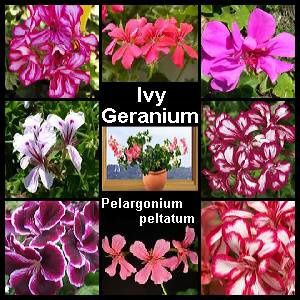 Botanical Name: Pelargonium peltatum
Botanical Name: Pelargonium peltatum  Humidity: Pelargonium peltatum generally requires just average levels of humidity.
Humidity: Pelargonium peltatum generally requires just average levels of humidity.  The succulent-type, light green ivy-shaped leaves and abundant blooms through most of the year's warmer months make Ivy Geraniums a well-favoured house plant, although it is typically purchased as outdoor ground cover.
The succulent-type, light green ivy-shaped leaves and abundant blooms through most of the year's warmer months make Ivy Geraniums a well-favoured house plant, although it is typically purchased as outdoor ground cover.  Repotting is best undertaken in spring, before buds appear. Providing containers with drainage holes is vital, as poorly draining, soggy soil easily results in stem and root rot. Over-watering may also result in a condition known as oedema, which can be identified by brownish water blisters appearing on the plant's leaves.
Repotting is best undertaken in spring, before buds appear. Providing containers with drainage holes is vital, as poorly draining, soggy soil easily results in stem and root rot. Over-watering may also result in a condition known as oedema, which can be identified by brownish water blisters appearing on the plant's leaves. 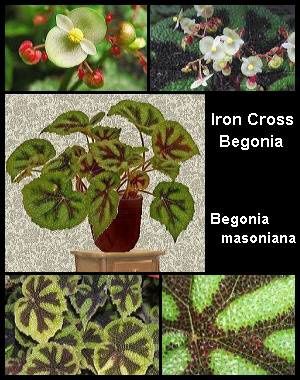 Botanical Name: Begonia masoniana
Botanical Name: Begonia masoniana  Temperatures: Like most Begonias, Begonia masoniana does not tolerate temperatures below 13 degrees C (50 degrees F) at all. Ideally, it should be kept in temperatures ranging between 18 and 24 degrees C (65 to 75 degrees F).
Temperatures: Like most Begonias, Begonia masoniana does not tolerate temperatures below 13 degrees C (50 degrees F) at all. Ideally, it should be kept in temperatures ranging between 18 and 24 degrees C (65 to 75 degrees F).  On occasion, this house plant may produce sprays of insignificant flowers, which are typically pinkish-white in colour. As they really are hardly worth mentioning, it is best to pinch these flowers off while still in bud, as this will promote growth of healthier, bigger leaves.
On occasion, this house plant may produce sprays of insignificant flowers, which are typically pinkish-white in colour. As they really are hardly worth mentioning, it is best to pinch these flowers off while still in bud, as this will promote growth of healthier, bigger leaves.  In spring, move your Begonia masoniana into a pot just one size larger than the old container. Only lightly tamp down the fresh soil, as this house plant prefers to have a little bit of air circling its roots. Naturally, the pot should have drainage holes.
In spring, move your Begonia masoniana into a pot just one size larger than the old container. Only lightly tamp down the fresh soil, as this house plant prefers to have a little bit of air circling its roots. Naturally, the pot should have drainage holes. 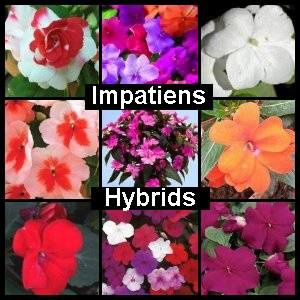 Botanical Name: Impatiens hybrids
Botanical Name: Impatiens hybrids  Temperatures: This house plant does best when kept in temperatures ranging between 16 and 24 degrees C (60 to 75 degrees F).
Temperatures: This house plant does best when kept in temperatures ranging between 16 and 24 degrees C (60 to 75 degrees F).  Impatiens hybrids provide a profusion of brightly coloured, gorgeous blooms fit to brighten up any window sill, patio or sun room. With oval, soft leaves on succulent stems, these house plants typically have fairly flat flowers with five petals. In the centre, there is usually a very prominent 'eye'.
Impatiens hybrids provide a profusion of brightly coloured, gorgeous blooms fit to brighten up any window sill, patio or sun room. With oval, soft leaves on succulent stems, these house plants typically have fairly flat flowers with five petals. In the centre, there is usually a very prominent 'eye'.  This house plant needs to be watered regularly to prevent it drying out and wilting. It is, however, important not to let the soil get soggy. Deadheading spent flowers will not only keep the plant looking tidy, it will also encourage more flowers.
This house plant needs to be watered regularly to prevent it drying out and wilting. It is, however, important not to let the soil get soggy. Deadheading spent flowers will not only keep the plant looking tidy, it will also encourage more flowers.  Botanical Name: Hydrangea macrophylla
Botanical Name: Hydrangea macrophylla  Water: The potting mix for Hydrangeas must be kept evenly moistened throughout their growing and flowering seasons. Soggy soil should, however, be prevented by providing adequate drainage. To prevent the potting mix from becoming alkaline, lime-free water should be used. During the winter months, the potting mix should be kept just barely moist.
Water: The potting mix for Hydrangeas must be kept evenly moistened throughout their growing and flowering seasons. Soggy soil should, however, be prevented by providing adequate drainage. To prevent the potting mix from becoming alkaline, lime-free water should be used. During the winter months, the potting mix should be kept just barely moist.  One of the main factors to remember when caring for Hydrangea macrophylla is that this plant needs moist soil - allowing it to dry out is likely to kill it. First signs of the soil getting too dry are yellowing leaves that eventually fall off. Provision of adequate indirect light (see above) is also vital for the health of this house plant.
One of the main factors to remember when caring for Hydrangea macrophylla is that this plant needs moist soil - allowing it to dry out is likely to kill it. First signs of the soil getting too dry are yellowing leaves that eventually fall off. Provision of adequate indirect light (see above) is also vital for the health of this house plant.  To over-winter an indoor Hydrangea, the plant should be repotted once flowering has finished, followed by cutting back stems by half. Kept cool throughout most of the winter months, the plant should then be moved into a slightly warmer environment near the end of winter in order to encourage blooming.
To over-winter an indoor Hydrangea, the plant should be repotted once flowering has finished, followed by cutting back stems by half. Kept cool throughout most of the winter months, the plant should then be moved into a slightly warmer environment near the end of winter in order to encourage blooming. 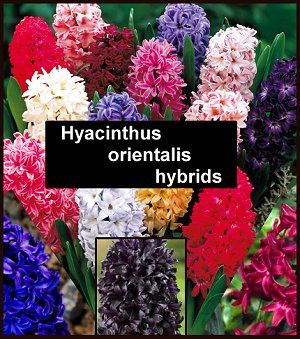 Botanical Name: Hyacinthus orientalis hybrids
Botanical Name: Hyacinthus orientalis hybrids  Temperatures: Hyacinth Flowers are best kept comparatively cool at temperatures ranging between 7 and 18 degrees C (45 to 65 degrees F).
Temperatures: Hyacinth Flowers are best kept comparatively cool at temperatures ranging between 7 and 18 degrees C (45 to 65 degrees F).  The process of getting the naturally spring-flowering Hyacinth Flower to bloom in the middle of winter is known as forcing. This essentially involves tricking the bulb into acting as though it has gone through the cold winter months before coming into the sunshine and warmth of spring - subsequently forcing it to bloom at a time when it would not normally do so.
The process of getting the naturally spring-flowering Hyacinth Flower to bloom in the middle of winter is known as forcing. This essentially involves tricking the bulb into acting as though it has gone through the cold winter months before coming into the sunshine and warmth of spring - subsequently forcing it to bloom at a time when it would not normally do so. 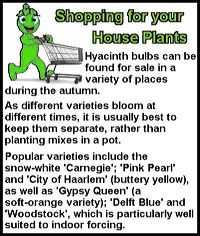 The plant can then be moved gradually - over a period of a few days - towards a sunny window. In order to ensure even growth, the pot should be turned daily. Once in full bloom, the plant should be kept in bright, but indirect sunlight to prolong blooming.
The plant can then be moved gradually - over a period of a few days - towards a sunny window. In order to ensure even growth, the pot should be turned daily. Once in full bloom, the plant should be kept in bright, but indirect sunlight to prolong blooming.  Botanical Name: Hibiscus rosa-sinensis
Botanical Name: Hibiscus rosa-sinensis  Humidity: This house plant requires moderate levels of humidity. Levels below 50 per cent need to be raised with the help of wet pebble trays and misting.
Humidity: This house plant requires moderate levels of humidity. Levels below 50 per cent need to be raised with the help of wet pebble trays and misting.  Hibiscus rosa-sinensis is an evergreen shrub with ovate, glossy dark green leaves that densely cover the plant's upright branches. From spring onwards, this house plant will produce a succession of blooms - each lasting for around 2 to 3 days - right through into autumn.
Hibiscus rosa-sinensis is an evergreen shrub with ovate, glossy dark green leaves that densely cover the plant's upright branches. From spring onwards, this house plant will produce a succession of blooms - each lasting for around 2 to 3 days - right through into autumn.  To prevent this gorgeous shrub from becoming too large to keep indoors, it needs to be pruned back - if necessary, by as much as half its size - early in spring. Pinching out growing tips will not only encourage branching - and subsequently a much fuller, bushier appearance - but will also encourage more abundant blooming.
To prevent this gorgeous shrub from becoming too large to keep indoors, it needs to be pruned back - if necessary, by as much as half its size - early in spring. Pinching out growing tips will not only encourage branching - and subsequently a much fuller, bushier appearance - but will also encourage more abundant blooming. 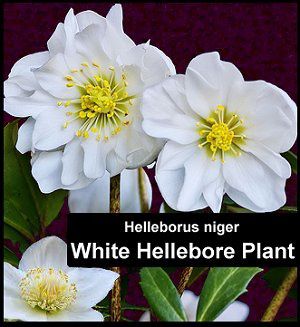 Botanical Name: Helleborus niger
Botanical Name: Helleborus niger  Temperatures: Hellebores prefer to be kept fairly cool, with temperatures not exceeding 7 to 18 degrees C (45 to 65 degrees F).
Temperatures: Hellebores prefer to be kept fairly cool, with temperatures not exceeding 7 to 18 degrees C (45 to 65 degrees F).  The beautiful white flowers of this plant may feature rounded or slightly pointed petals (giving them a star-like appearance), depending on the particular hybrid purchased. Held on thick, upright stems, the flowers open out flat and form a lovely contrast to the plant's shiny, thick leaves.
The beautiful white flowers of this plant may feature rounded or slightly pointed petals (giving them a star-like appearance), depending on the particular hybrid purchased. Held on thick, upright stems, the flowers open out flat and form a lovely contrast to the plant's shiny, thick leaves.  With a little care, a cool shaded spot and regular watering - though over-watering should be avoided to prevent root rot and yellow leaves - this enchanting plant will brighten the late winter/ early spring months with its shiny leaves and gorgeous flowers for many years to come.
With a little care, a cool shaded spot and regular watering - though over-watering should be avoided to prevent root rot and yellow leaves - this enchanting plant will brighten the late winter/ early spring months with its shiny leaves and gorgeous flowers for many years to come. 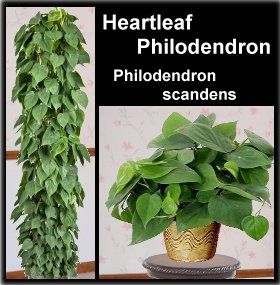 Botanical Name: Philodendron scandens
Botanical Name: Philodendron scandens  Humidity: Though it tolerates dry air, this plant prefers some humidity. Misting the foliage from time to time will keep it quite happy.
Humidity: Though it tolerates dry air, this plant prefers some humidity. Misting the foliage from time to time will keep it quite happy.  Also often referred to as the Sweetheart Plant, the popular Heartleaf Philodendron is an easy to grow house plant.
Also often referred to as the Sweetheart Plant, the popular Heartleaf Philodendron is an easy to grow house plant.  In spite of its tropical native habitat, P. scandens will tolerate fairly dry air, but does appreciate the occasional misting. Happily thriving in fairly small pots for years, these house plants should be repotted - during spring/ early summer - every two to three years. To prevent root rot, adequate drainage must be provided.
In spite of its tropical native habitat, P. scandens will tolerate fairly dry air, but does appreciate the occasional misting. Happily thriving in fairly small pots for years, these house plants should be repotted - during spring/ early summer - every two to three years. To prevent root rot, adequate drainage must be provided. 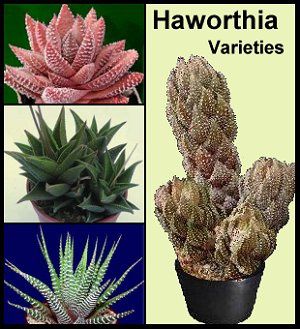 Botanical Name: Haworthia species
Botanical Name: Haworthia species  Temperatures: From spring through into autumn, Haworthias are content with average room temperatures between 18 and 24 degrees C (65 - 75 degrees F). If possible, these plants should be kept cooler - at temperatures around 16 degrees C (60 degrees F) - during the winter months.
Temperatures: From spring through into autumn, Haworthias are content with average room temperatures between 18 and 24 degrees C (65 - 75 degrees F). If possible, these plants should be kept cooler - at temperatures around 16 degrees C (60 degrees F) - during the winter months.  The vast majority of Haworthia species remain comparatively small, although some species feature inflorescences that can reach heights of around 40 cm (16 in) or more. Forming either clumps or remaining solitary, these succulents come in a variety of colours, and some may be spotted; some are striped and some are just plain green.
The vast majority of Haworthia species remain comparatively small, although some species feature inflorescences that can reach heights of around 40 cm (16 in) or more. Forming either clumps or remaining solitary, these succulents come in a variety of colours, and some may be spotted; some are striped and some are just plain green.  This is also a good time to remove and pot any offsets for propagation. As the roots of this plant are fairly small, they can be planted into fairly shallow containers, and - if a container without drainage holes is used - a thin (2.5 cm / 1 in) layer of pebbles placed into the bottom will provide all the drainage needed.
This is also a good time to remove and pot any offsets for propagation. As the roots of this plant are fairly small, they can be planted into fairly shallow containers, and - if a container without drainage holes is used - a thin (2.5 cm / 1 in) layer of pebbles placed into the bottom will provide all the drainage needed.